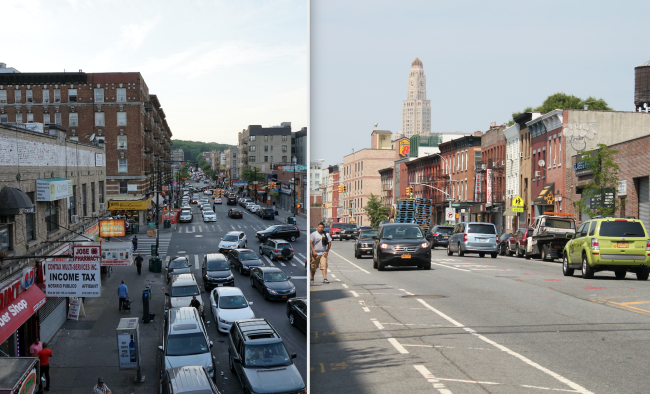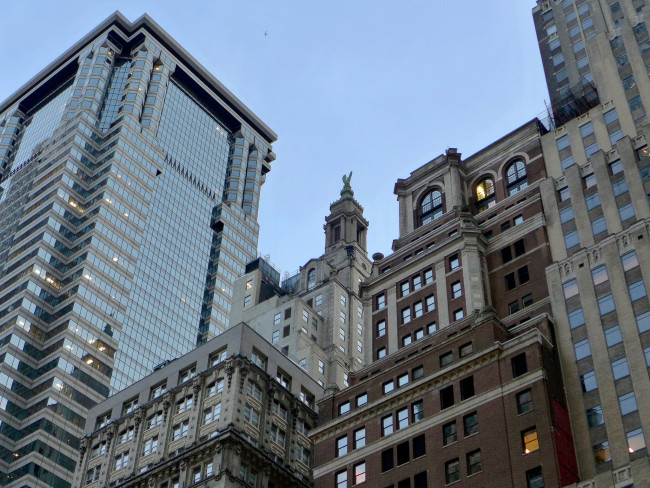How Covid-19 may change the rezoning process in New York City
In New York City, one of the main tools used to push through major changes to the built environment is the uniform land use review procedure (ULURP), which was put on hold in March because of the coronavirus crisis. The process is due to resume in mid-September, with the city considering big developments like the rezonings of Industry City and Gowanus. And once it gets going again, big changes may be in store—some necessitated by the Covid-19 crisis itself, and others triggered by the systemic inequities that the pandemic has laid bare.
Rezonings are often used to implement large-scale changes within neighborhoods, such as creating more affordable housing, increasing the density of new buildings, and encouraging a diverse mix of uses for new developments. Such is the case with many of the rezonings undertaken by the de Blasio administration, including those in Inwood, East New York, and East Harlem.
But rezonings can also be contentious because of those changes. In recent years, studies have shown that the impacts of broad zoning changes often hurt the communities that they’re supposed to help—lower-income New Yorkers, and people of color. Those communities have also been disproportionately impacted by the Covid-19 crisis, and many believe the city should be doing more to address their immediate needs rather than implement sweeping changes.
That’s a viewpoint that some see as being potentially harmful to future development in the city. “There's a mindset among certain people that development has to be channeled to solve a lot of social ills. And I think there's certainly room for that; it's ongoing and it's appropriate up to a point,” says David West, a founding partner at the architecture firm Hill West, which has worked on buildings in rezoned districts. “But remember, without major public subsidy, these things have to be driven by private developers who have profit motives so there's only so much social justice you can load up on a project and have it make sense.”
Virtual meetings as the norm
When the city resumes the ULURP process in mid-September, the multiple hearings that would typically happen in-person will instead be entirely remote. Normally, stakeholders in the process (including developers, elected officials, and community members) show up to several public meetings held by community boards, the City Planning Commission, and the City Council. These hearings often get very heated, particularly at the Council level, when the final vote on a project (before the mayor signs off) takes place.
Social distancing mandates will make that process virtual, with public meetings and community input due to happen via Zoom or other digital platforms. Some view this as an improvement, giving people who might not normally attend a public meeting—whether because of timing, or trepidation about getting involved—access to the process.
“Our office has found remote meetings to be pretty effective—at least for community boards, more people have participated in meetings,” says Gale Brewer, Manhattan borough president. “While there is certainly a value in in-person hearings and meetings, I think we would like to see a hybrid moving forward. We also do a lot of hard work to make sure there’s a lot of notice especially as advocacy groups have been getting more involved online.”
But others believe this could hamper the quality of the feedback. In an op-ed for City Limits, New York state Assemblymember Jo Anne Simon (whose district includes Gowanus, a neighborhood that may be rezoned) and Gowanus resident Brad Vogel, the captain of the neighborhood’s popular canoeing club, argue that all-virtual ULURP is not “fair and sufficient” for the process.
“To be able to coordinate, cheer, clap and even boo from time to time is an essential part of the process—and that can only happen at a large, in-person meeting, the kind where it’s possible to hold signs or wear clothing sporting advocacy messages,” they wrote.
A focus on racial equity
Even before the coronavirus crisis, people were scrutinizing the role that rezonings play in gentrification and displacement throughout the city.
In early 2019, Public Advocate Jumaane Williams introduced legislation in the City Council that called for requiring a racial impact study to be conducted as part of the review process for any land use action, such as a neighborhood-wide rezoning. And in December 2019, the advocacy group Churches United for Fair Housing released a report that showed why such a study may be necessary: Two major Bloomberg-era rezonings in Park Slope and Williamsburg accelerated “racialized displacement” in those neighborhoods.
“After being rezoned, these communities experienced changes that were not anticipated by the City at the time they made the zoning changes,” the report reads. “Compared to the predictions contained in city documents related to the rezonings, there was greater population growth as well as higher losses of manufacturing space and rent-stabilized housing units.”
The coronavirus crisis has only exacerbated the deep inequities in the city: Many people who were already on the margins are facing evictions or homelessness because of lost wages or other coronavirus-related issues.
“I want [racial impact studies] to be required of every zoning,” says City Councilmember Brad Lander, who is a co-sponsor of Williams’s bill. “I want us to do comprehensive planning in which we actually think about what it would look like to achieve racial equity and fair housing, in addition to environmental sustainability and a wide range of other goals before we start doing rezonings.” (Lander represents Gowanus, where a major rezoning could get underway in the next few months, and he has said it should not be delayed in order to conduct a study.)
While this may be more of a focus in the future, there has been some pushback: In July, Curbed NY reported that a judge overturned a ruling that would have required a racial impact study for the stalled Inwood rezoning, which was initially approved in 2018 but has been held up by lawsuits. The ruling “essentially declares that because the city doesn’t have a legal obligation for a greater study of these neighborhood impacts — regardless of their staggering importance to communities — the de Blasio administration simply doesn’t have to take a deeper look,” Curbed reported.
Opposition to megaprojects
Large-scale developments, including rezonings, always have their detractors, but the coronavirus crisis has made their concerns more urgent.
“These projects will not save us,” says a representative from Justice for All Coalition, which has organized a diverse group of Queens residents (including longtime NYCHA residents, small business owners, and artists) under one umbrella to oppose developments like Sunnyside Yard, and the rezoning of Anable Basin.
“We know the affordable housing and jobs these projects bring to our communities do not address the immediate needs of or structural inequality facing residents,” the Justice for All representative says. “It is unconscionable to us that the city is allowing the moratorium on ULURP to expire at a time when 200,000 tenants are facing eviction from cases prior to Covid-19, 25 percent of tenants in the city who haven't been able to pay rent will be facing eviction come October 1st, and a third of small businesses may shutter.”
In some cases, elected officials have joined opponents of these rezonings. Industry City in Brooklyn is one area gearing up for a large-scale zoning change as the ULURP process gets underway, but Carlos Menchaca, the councilmember who represents the district, does not support the project.
“It is clear to me that the displacement and gentrification our city is combatting today is the result of giving private developers free reign,” Menchaca said in an Instagram video posted on July 28th. “We must learn from our mistakes and deliver what New Yorkers really need: stable housing, access to affordable and nutritious food, guaranteed health care, and good-paying, family-sustaining jobs.”
Public advocate Williams also condemned the rezoning, pointing to the need for a racial impact study before it proceeds. “Jobs are essential, in this crisis and beyond it, but this rezoning is not a way to spark and sustain economic and community health,” he said in a statement. “Like the Hudson Yards project before it, which now siphons crucial city resources while doing nothing to help everyday New Yorkers, this proposal is not a short term solution to the city's economic situation, and it could have long term negative consequences.”
A push for more housing
Others believe that the housing crisis that the pandemic has exacerbated can be fixed by adding more housing through zoning changes. A new report by the Citizens Budget Commission, a nonprofit organization, found that housing production in New York City has decreased in the past decade, leading to “higher rates of overcrowding, persistently low vacancy rates, and a rapidly declining number of housing units that are affordable to low- and moderate-income households.”
“We see this as a doubling down time, not a time to change course,” says Dan Miller, a member of the pro-housing group Open New York. The group formed in 2018 and has advocated for adding more housing to neighborhoods that it calls “high opportunity”—i.e., ones that are wealthier and whiter than areas that have previously been targeted by rezonings. So far, it has thrown its weight behind the proposed rezonings of Soho and Noho, as well as Gowanus. A long-term goal would be to change zoning codes at the city or state level to require more dense housing near transit stops, for example.
“The Open New York vision is one of housing abundance,” Miller says. “If you want to move or if you want to move to New York City, you should be able to find an apartment easily. You shouldn't have to pay an absurd amount for a postage-stamp-sized apartment. It's about freedom to navigate the city in a way that makes sense for your life.”
More mixed-use development in outerborough neighborhoods
With more people working from home because of Covid-19, New York City’s traditional business districts have seen a substantial decrease in foot traffic—which could lead to a shift in what a “central business district” might look like in the future.
“People have learned that they don't have to all get on the same transit every day at the same time of day and go to a central business district in order to conduct their business,” says West of Hill West. “There are really vast areas of the city that are zoned [for] low-density residential, that are built up with three- or four-family houses and little shopping centers, and it just doesn't really reflect the way people live and work now. I think zoning should really allow for integrations of the various types of uses better.”
West points to special zoning districts that the city has created in recent years, such as Hudson Square, as an example of how different zoning uses—residential, commercial, and retail — can coexist side-by-side, and perhaps be implemented in areas that are further from the traditional office hubs like Midtown Manhattan or the Financial District.
“Zoning is going to have to change in order to follow that or enable it,” West says. “It usually picks on trends that already have some impetus for happening and then tries to encourage them and shape them.”




























